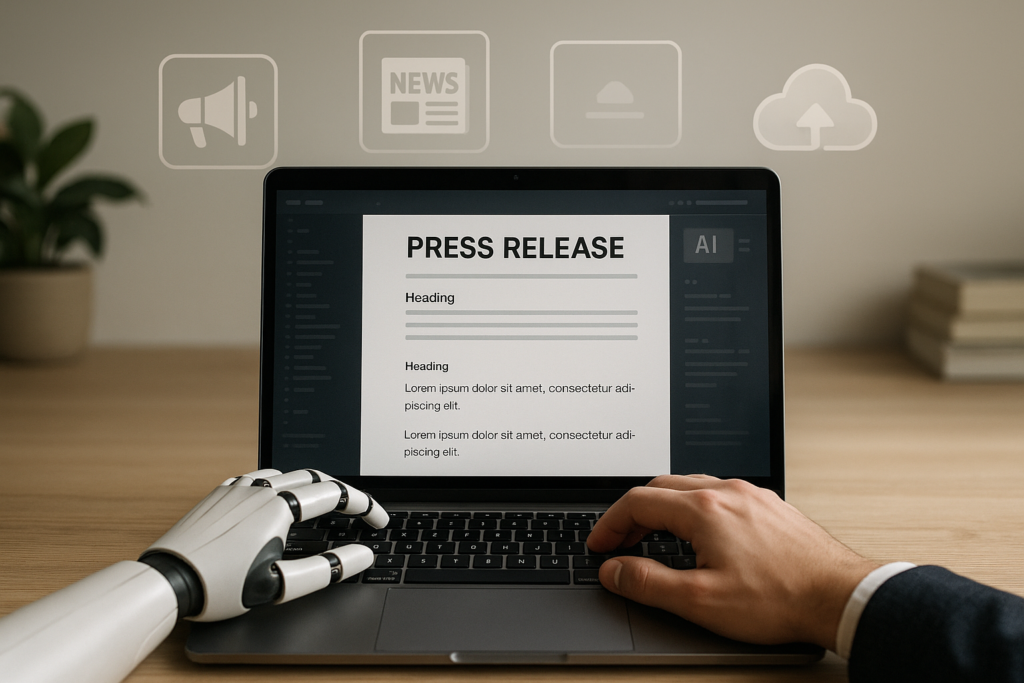Writing a press release used to take hours. Sometimes days.
Between researching, editing, and chasing the perfect headline, most teams spent more time crafting the message than actually getting it out.
Now?
AI tools can generate full press releases in minutes. They’re fast, consistent, and surprisingly good at mirroring brand tone when used right.
If you’re curious about how an AI press release generator works, or wondering if it’s worth using, this guide breaks it all down.
What Is an AI Press Release Generator?
Before we get into tools and use cases, let’s define the core idea.
An AI press release generator is software that uses artificial intelligence—usually a large language model—to create structured, ready-to-publish press releases based on your input.
It doesn’t guess or spin ideas out of thin air. These tools are trained on thousands of examples and follow the standard press release format: headline, subheadline, dateline, lead, body, boilerplate, and call-to-action.
You provide the details—what happened, who’s involved, why it matters—and the AI handles the structure and flow.
The outcome is a professional, polished draft you can refine and publish in a fraction of the time it used to take.
Let’s unpack how it actually works.
How It Works Behind the Scenes
At the heart of every AI press release writer is a language model trained on massive amounts of text—think press releases, news articles, and corporate communications.
These models don’t “understand” language the way humans do, but they’re excellent at predicting what comes next in a sentence based on patterns.
When you enter a prompt—something like “New product launch from a tech startup in San Francisco”—the tool maps that input to a familiar structure.
It knows a headline goes first, then a dateline, then a lead paragraph with the who, what, when, and why. The AI fills in each part with content that mirrors human writing style.
Some advanced press release AI tools also allow you to fine-tune the tone (formal, conversational, bold), insert brand voice guidelines, or select templates based on industry.
The more context you give, the better the output tends to be.
AI vs Traditional Press Release Writing
Traditional press release writing takes time—and usually a team.
You’ll often have a PR specialist draft the release, an editor polish the language, and someone else handle formatting and distribution. It’s reliable, but not exactly fast or scalable.
An AI press release generator flips that workflow. Instead of starting from scratch, you enter key facts into the tool and get a full draft in seconds.
No staring at a blank page, no waiting on revisions.
That said, human writers still have the upper hand when it comes to nuance, narrative flow, and instinct.
AI handles structure and speed. Humans refine. Together, they create better press releases—faster.
Key Benefits of Using AI for Crafting Press Releases
AI tools aren’t just time-savers—they’re changing how brands approach media communication.
From speed to consistency, here’s what makes them valuable.
Faster Turnaround Time for Urgent News
When something breaks—funding, launches, executive moves—you don’t always have hours to write.
An AI press release writer can generate a first draft in under five minutes. That means quicker internal approvals and faster media distribution.
Cost-Effective Compared to Hiring Writers or Agencies
Working with PR firms or freelance writers can get expensive fast. With press release AI tools, you can scale output without scaling cost.
Whether you’re publishing weekly or monthly, the ROI adds up quickly.
Enhanced Consistency Across Brand Messaging
AI doesn’t forget your voice. Once you establish tone, style, and structure, the tool applies it across all your releases.
That kind of consistency is hard to maintain with rotating teams or multiple contributors.
Data-Driven Customization and Optimization
Some AI press release generators go beyond writing—they analyze readability, keyword density, and even suggest headline tweaks based on performance trends. That’s a level of optimization traditional PR workflows rarely include by default.
Common Use Cases for Press Release AI Tools
AI isn’t limited to one type of announcement.
Its flexibility makes it useful across a wide range of press release scenarios—especially when time and clarity matter most.
Product Launches and Updates
Whether you’re releasing a new app or updating a legacy feature, AI tools help frame the message with precision.
You get a strong headline, a clear benefit statement, and just enough technical detail to keep readers interested without overwhelming them.
Event Announcements and Recaps
Need to announce an upcoming webinar or summarize a successful conference?
A good AI press release generator can quickly format your event details into a compelling narrative that media contacts and followers can easily pick up.
Crisis Management & Reputation Response
In high-pressure situations, timing is critical.
AI tools can draft an initial response fast—something PR teams can review, tweak, and approve before going live. It’s not about skipping strategy, but speeding up execution.
Funding Announcements & M&A News
Financial press releases require clarity, compliance, and confidence.
AI tools trained on industry-specific language can help you frame the numbers, name the key players, and present your milestone in a way that earns media trust.
What to Look For in an AI Press Release Writer Tool
If you’re investing in a solution to help write press releases, it’s worth knowing which features make a real difference.
Customization Options
Look for tools that let you tailor tone, industry focus, and target audience.
A generic press release won’t get picked up—your tool should let you shape the voice and style to fit your brand and the moment.
SEO Optimization Features
The best AI for crafting press releases doesn’t just write—it helps you get found.
Built-in SEO suggestions, keyword prompts, and meta descriptions give your release a better shot at visibility on Google News and other platforms.
Template Variety and Formatting
Some tools offer multiple press release templates: one for product launches, another for crisis statements, another for event recaps.
Bonus points if the formatting follows standard journalistic style like AP or PRNewswire guidelines.
Fact-Checking and Human Review Integration

Accuracy still matters. Even the best AI press release tool can get details wrong.
Choose one that allows human edits and suggests factual checks before hitting publish. A good tool works with your PR team—not instead of them.
Examples of AI Press Release Generators in Action
The best way to understand the power of press release AI tools is to see them in the wild.
Real brands are already putting them to work—and seeing results.
Real-World Brands Using AI Press Release Tools
Companies across tech, e-commerce, and even healthcare are experimenting with AI for press communications.
Startups use it to move fast without a dedicated PR team.
Larger brands use it to scale their announcements without overloading in-house writers.
From product launches to sustainability reports, AI is already writing the first draft.
Sample Outputs: Human vs AI Press Release Comparison
When you compare a human-written release with one generated by an AI press release writer, the structure is often nearly identical.
What stands out is efficiency. AI versions tend to be shorter, clearer, and more neutral in tone—ideal for initial drafts that humans can refine for punch or voice.
These examples don’t prove that AI is better—they show that it’s capable. And for busy teams, that’s more than enough to make it worth using.
The Limitations of AI in Press Release Writing
For all its speed and structure, AI still has blind spots.
Knowing where it falls short helps you use it more effectively—and avoid the common pitfalls.
Risk of Generic or Overused Phrasing
AI tools are trained on millions of text samples. That means they often fall back on safe, predictable language.
Phrases like “industry-leading,” “groundbreaking solution,” or “driving innovation” show up a little too often. Without edits, your press release can feel templated.
Lack of Nuance or Industry-Specific Insight
A press release about a biotech breakthrough or legal settlement needs more than clean grammar.
It needs context, compliance, and sensitivity. Even the best AI press release generator can miss the deeper story behind the news—something human writers naturally catch.
Factual Errors and the Need for Human Oversight
AI tools can occasionally invent numbers, titles, or names—especially if the input isn’t specific enough.
That’s why editing and fact-checking aren’t optional. Think of AI as your draft assistant, not your final reviewer.
How to Use an AI Press Release Generator Effectively
AI is powerful—but only if you know how to guide it. The best results come from pairing smart input with thoughtful editing.
Start with a Strong, Clear Prompt
Your results are only as good as your input. Include the who, what, when, where, and why. Be specific.
For example: “Announcing a $10M Series A funding round led by XYZ Ventures in San Francisco to expand product development.”
That gives the AI a strong foundation to build on.
Review, Edit, and Customize the Draft
Even if the structure is solid, you’ll still want to refine it. Polish the tone. Swap out generic phrases. Add a quote from your CEO.
This is where the human touch makes a difference—turning a solid draft into a newsworthy release.
Use It As a Drafting Partner—Not a Final Voice
The smartest way to use an AI press release writer is as a collaborator. Let it handle the heavy lifting.
You focus on the angles, tone, and details that matter most to your brand. It’s not about cutting corners. It’s about cutting time without cutting quality.
The Future of AI for Press Releases and Public Relations
AI isn’t just a passing tool. It’s reshaping how public relations teams think, act, and communicate.
Will AI Replace PR Writers?
Not likely. AI handles structure and speed well, but it still struggles with nuance, strategy, and brand intuition.
Human writers understand context, emotion, and timing—things algorithms can’t replicate.
The future looks more like partnership than replacement.
Emerging Trends in AI Press Release Technology
We’re already seeing tools evolve. Some now include voice input, so you can speak your idea and get a draft instantly.
Others offer multilingual output or integrate with analytics dashboards that track engagement and pickup.
The smartest tools are becoming more collaborative, not just generative.
Integration with PR Distribution Platforms
A few AI tools now connect directly with services like PR Newswire or Business Wire.
That means you can go from draft to distribution in one workflow. It’s a game-changer for speed and simplicity—especially for lean teams managing multiple campaigns.
How Trelexa Helps You Write Smarter Press Releases with AI
At Trelexa, we don’t just hand you a press release generator and walk away.
Our AI-powered system combines fast drafting with expert oversight—so you get polished, professional releases in record time.
You start with a few simple inputs. Our tool handles the heavy lifting, delivering a structured draft that sounds like it came from a seasoned PR pro.
From there, our human editors fine-tune the language, fact-check the content, and make sure your message hits the right tone.
Whether you need a one-off release or ongoing support, Trelexa blends automation with human intelligence—so you can move faster, say it better, and stay ahead of the story.
Final Thoughts
AI has changed the way we approach press releases—turning what used to be a slow, manual process into something fast, flexible, and scalable.
When used well, an AI press release generator becomes more than a tool. It becomes your starting point for stronger, clearer communication.
Ready to write press releases that save time and still sound like you?
Trelexa’s AI-powered service is built to help you move faster without losing the human touch.
Get in touch today and let us help you craft your next headline-worthy story.

